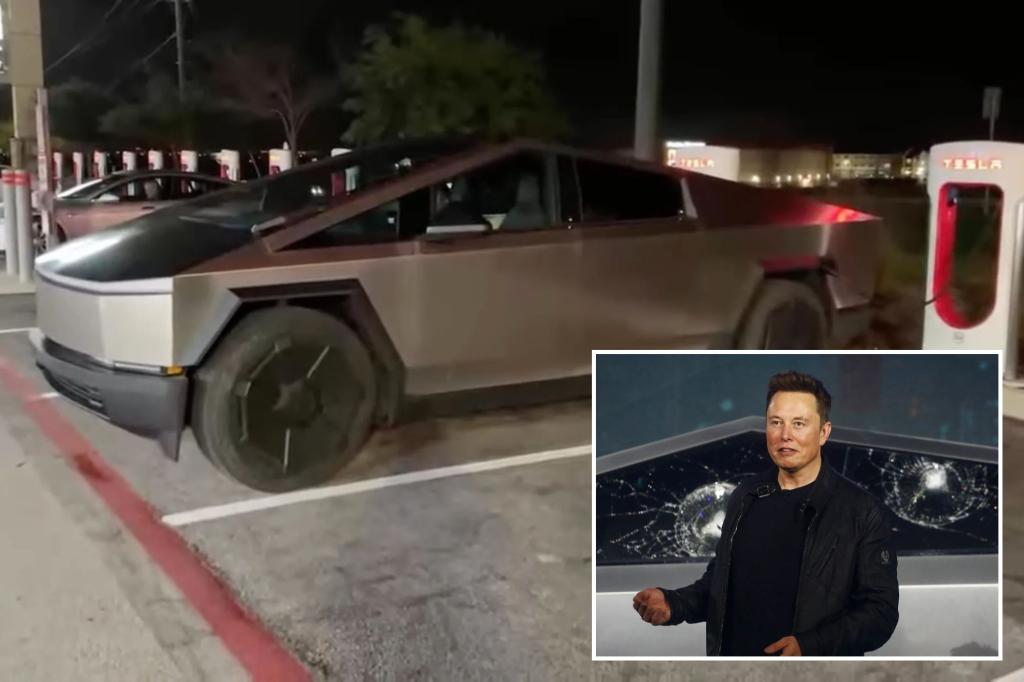Tesla Cybertruck gets less than 80% of advertised range in YouTuber’s test::A YouTuber took Tesla’s Cybertruck on a ride to see if it can actually hit its advertised 320-mile range, only to find out that its could only reach 79% of the target. When YouTuber Kyle Conn…
I remember when top gear tested a Tesla and found the range they quoted to be wildly over estimates. Tesla lost the lawsuit.
That article’s from 2012, before Elon Musk popularity took off, and yet you can already get a foreshadowing sense of Musk off the article:
Tesla Motors CEO Elon Musk called Top Gear “completely phony” and his company sued for libel and malicious falsehoods.
Top Gear were completely phony though, they purposefully ran the battery flat before the demo. This is known. Elons a douche but so is Clarkson.
Also, IIRC, Top Gear have always had a blase attitude towards their influence in the motor world. Given their reputation as petrol heads, and the fact that their review was also critical of the impact of EV’s on the environment, they’ve often fell back on the “we’re an entertainment show, you’re not supposed to take us as experts”, when many manufacturers have often said a negative review could cause significant harm in sales.
In all fairness though both Hammond and May currently own Teslas.
Check the results of other cars in this test here: https://outofspecstudios.com/70-mph-range
Yeah ambient temperature dramatically affects the range of EVs. One time I took my Model 3 on a roadtrip and I had quite a bit of range left when I got to the hotel, but the next morning the temperature had plummeted and suddenly I had to make for the nearest charger instead of continuing on for a while. It’s just something we have to get used to with EVs I guess.
It’s the same with gas, you just didn’t notice it as much. Gas cars definitely get way lower mileage in the winter.
In mine the torque converter clutch won’t lock until the transmission is warm. That takes a while in winter.
You notice some differences just from the air temperature going into the engine too. Especially in a turbocharged car.
Colder air means denser air. Denser air means more oxygen molecules in the same volume of air. More oxygen means the engine can put more fuel and produce a bit more power.
Depending on your driving style, i.e. If you have a heavy foot, this means a bit more power and fun, but you’re burning a bit more gas too.
Denser air also means more drag. Few IC cars are optimised for aerodynamics
Something else i dont see mentioned often either is that ICE cars generate heat as a waste byproduct of producing power, but electric cars dont produce usable heat, so if your in an area where its cold then using the AC heating will be additional battery usage coming off your driving range
By FAR the biggest impact on range in the winter for me is climate control.
Sounds more like something they need to solve in EVs
Musk lied about something? Ooooh no, he’s never done that before. /s
People who do business with tesla deserve what they get.
Industry average results?
Shoddy build quality and no physical buttons
Build quality was shit maybe 7 years ago, today’s model 3 and y are fine, especially those made in China and Germany. And physical buttons are going away industry wide.
https://insideevs.com/news/701296/vw-physical-controls-to-return
https://www.thedrive.com/news/we-saw-the-tesla-cybertruck-up-close-panel-gaps-and-all
And then there is this
Teslas are shitboxes controlled by a man child full of false promises and if you buy one at this point you are a moron, sorry
Notice how I mentioned model 3 and y, which are the ones selling millions, not musk’s ego trip cybertruck?
Promises are nice, let’s see the model interiors in a few years.
I only notice how you claim the build quality was only shit 7 years ago, which is demonstratively false if the problems still occur with the cybertruck.
On the model 3 and y. Which are the ones most people buy.
Lets see if there is a tesla in a few years once the class actions drop over the false promises they made
They were careful enough to never promise anything in contracts, just on Twitter or TV interviews. The WLTP ratings are done by external testers, I imagine the EPA ratings are similar. They will settle out of court maybe for misleading advertising for somethimg, owners will get a check in the mail for 40 cents and that will be it.
you’re right about the buttons, but Teslas have been demonstrated to be very low quality in various tests recently published. they were ranked even below Dacia.
That is not about quality if you mean the TÜV stats. That’s about brakes not being used enough and getting some deposits/oxide.
ikr they deserve exactly normal damn it
Also, the Murdochs are known to fan out the EV bullshit that is being sold these days via their channels.
It’s only a matter of time before driving an EV is considered woke.
It definitely already is and some people will literally buy huge gas sucking trucks that they don’t need just to stick it to the libs or whatever
Just throwing away money really but the reasoning is insane
Already there, a conservative I know said to me “it’s only matter of time until they make us all drive EVs”
Which is true, many countries have planned bans on the sale of new ICE cars by 2035. Which is good, even now electric cars are starting to be competitive without subsidies.
I would maybe extra-tax ICEs instead of banning them, so you still have your exotic cars with vroom sounds…
Did the YouTuber run the same type of test that the EPA would run?
I feel like every car I’ve ever owned has had worse milage than what’s on the sticker. But maybe I have a lead foot.
You probably do have a lead foot. I can usually best the sticker mpg especially with hybrids.
Is hypermiling different in a hybrid or an EV compared to say an old manual transmission ICE?
EDIT: To be more clear, I guess I was more curious about techniques used. I already am aware how much waste heat and energy there is in ICE vehicles.
One difference is EVs have regenerative breaking. Using your brakes in an ICE is 100% wasted energy, while regen breaking in an EV returns some (I don’t know what percentage) of the car’s kinetic energy back into the battery.
Hybrids have regen as well. Some phevs and some evs let you set the regen strength so you can either brake by letting off the accelerator (highest return to the battery) or you can just coast (lowest return) or somewhere in between.
For more info, look for one pedal driving. If either my current or last car had adjustable regen I’d probably be able to do even better with efficient driving.
It’s far more effective in an EV. With an ICE about 80% of the energy is just generating heat so you’ve only really got the remaining 20% that you can influence.
I don’t think that’s true. The issue is the amount of storage available for the regen to go. With a regular hybrid you have enough battery for maybe a couple of miles on battery depending on several factors. With a plug in you have anywhere from 15 to 30+, I think the latest prius was supposed to have something like 100 miles of range. With the larger battery the regen can be more effective on the efficiency.
It’s also dependent on the strength of the regen. There is what people are calling one pedal driving when the regen is set as high as possible, the motors will immediately start slowing the vehicle as soon as you let off the accelerator. The regen is also way more effective in the city. On the highway you’d probably want it set as low as possible. I don’t yet have a vehicle with adjustable regen so I haven’t personally tested out various scenarios to figure out what is more efficient.
The regen level probably makes no difference if combined with already efficient driving. The idea of coasting by letting off the pedal fully in an EV is flawed. You “coast” in an EV by holding the pedal in a neutral power setting.
I’ve worked some hypermiling concepts into my driving but I don’t really go full on with it. I still haul ass on the highway and will gun it when needed.
The easiest things people can do are overinflating your tires by 10-15% along with watching both upcoming stop lights and the brake lights of the cara in front of you and not just the one directly in front of you, when it looks like traffic is slowing down, let off the gas and coast. I coast as much as I can, especially towards red lights, stop signs and highway congestion.
He ran his standard test. Most other EVs in this test exceed the EPA range, most notably he recently tested the EV9 (a literal brick) in similar temperatures.
Good to know. Sounds like this is just the same old shit Elon / Tesla just got slapped for by the feds.
The EPA highway test is 55mph or something around that. These real world tests are all 70mph+
The only way you do better or equal on a 70mph test is
-
Advertise a smaller range than you actually have
-
Gear the motor for high speed and have worse performance at lower speeds (EVs typically do better at low vs high, but you could make low even worse)
-
Have a multi gear motor like Porsche and I think some Audi. Then you don’t have to optimize the motor on 1 gear, but it substantially increases cost (but it’s a porsche) and complexity and repair costs.
The EPA just needs to make a 70mph test part of the test cycle and make them advertise that.
The gearing in the Taycan/E-Tron GT aren’t for efficiency, but for speed. Electric motors don’t really lose efficiency as they spin faster, but they do start to lose the ability to move the car faster against the exponentially increasing wind resistance. This isn’t an issue for most cars (they top out around 110mph), but for something like the Taycan it’s important (tops out around 155mph).
The 70mph situation is more that manufacturers de-rate their cars. Both the Taycan and the Lyriq (a SUV brick) are well-known for demolishing their EPA ranges in 70mph cruising tests. Even the EV9 (the brickiest brick) exceeded the EPA range in this same test.
Unrelated to my other reply - but I think it’d be interesting to see how much other manufactuers de-rate their cars, by having independent testers also run an EPA test just like they run real world tests.
I’d love to see them run reports saying XYZ car has an actual epa range of XYZ even though they report ABC
This is right from energy.gov
https://www.energy.gov/eere/amo/articles/determining-electric-motor-load-and-efficiency
Most electric motors are designed to run at 50% to 100% of rated load. Maximum efficiency is usually near 75% of rated load. Thus, a 10 horsepower (hp) motor has an acceptable load range of 5 to 10 hp; peak efficiency is at 7.5 hp.
They also run more poorly below 50%.
To get a good city/highway range they would need to try and keep the motor above 50% for city, while also keeping it
underaround 75% for highway. How you move that gearing will impact range at higher speeds or lower speeds. Maybe it’s not as much as I think, but it definitely comes into play, and the Taycans geared motor helps some amount.Tesla has definitely honed their motors to maximize the EPA range vs higher speeds in addition they aren’t de-rating like some other manufactures do.
-
Wow, just like the cars!
As someone who bought one of their cars the only real positive is that the charging network is available 24 hours a day and very prominent across most of my travel routes.
Additionally, I would say wait out for this industry to get better since every single manufacturer of EV’s is full of absolute horse shit in regards to range and safety, ESPECIALLY anything not coming from USA or Europe. Byd’s are fucking death traps
Intrigued about your BYD claim - got anything to back it up?
Thanks mate.
BYD is going to destroy Kia in the states in the 30s
im in the industry cant wait to kill car town kia
That explained absolutely nothing
Ha, I don’t have a choice in California. So I’m stuck reading the tea leaves to find the best of the bunch.
I haven’t done a ton of research on the matter so definitely take this with a grain of salt but I have heard that the volt has been receiving pretty good reviews.
I would say for sure that you’ll want to investigate a TON before making your purchase, you do not want to end up in a tesla situation like I did where an update to the car after a lawsuit provides direct evidence that tesla lied to everyone about the range of the vehicles.
The price/performance ratio on tesla vehicles made sense when they were still in development, but tesla is now one of the largest companies in the world and should not be allowed to screw their customers over like this anymore, but I feel the same way about most technology companies these days and the law, unfortunately, does not appear to agree.
Tesla has done a lot of scummy shit and they have likely outrightly lied about their range but pretty much all vehicle manufacturers do to some point.
Fuel efficiency is measured in both highway and whatever cool term the company likes such as ‘city, urban, commute’
They do these tests on test tracks, windows up, no AC, no quick acceleration or braking etc and THEN they combine them and spit out an average of the two numbers and tell you to expect that fuel economy.
It does not happen and I’ve heard of multiple court cases against manufacturers alledging they’ve lied and the fuel efficiency they state is impossible. I don’t think any large manufacturers have lost however.
Anyway, point being - range is usually exaggerated quiet a bit. It may be about to get those numbers in a completely unrealistic scenario but actually obtaining them in the real world, in traffic etc - they are all liars.
Yeah I’m hopeful for the Bolt and a similar cost competitor that isn’t on GM’s problematic platform.
Gaming laptop of trucks and cars
i Only buy chinese old fashion car battery electric cars
Lithium fire is not a joke
Heh here’s one for people. In my province at least the best way to get cheap 24/7 fuel in every corner even the podunkest no stoplights villages is to get a free membership with the local fuel co-op (UFA here)
I regularly save 2-10 cents a litre and have 24/7 access and even shitters and showers in most locations all for no extra money or work on my end other than the initial sign up.
I hope that works out for everyone that uses it but the key reason I ended up getting an electric vehicle after my ICE vehicle broke down was to avoid oil and gas prices, especially in regards to the continuing degradation of the geopolitical situation in the middle east where OPEC+ produces and transports more than 80% of the world supply of usable oil.
I hated waking up and wondering if the dice roll would break my bank that day. Although my car ended up a fair bit more expensive than I had wanted, the vehicle has nearly paid for itself with all the charges I didn’t have to pay at the pump.
This isn’t an endorsement for electric vehicles just a note of a positive side that I personally was able to avoid.
If my country wasn’t completely backwards and we had more nuclear facilities and less dependence on oil barons, I’d be happier, but the reality is not everyone has the ability to change over, and even I would still be using an ICE vehicle today if insurance didn’t cover the rest of the price of my old car when my accident happened.
That’s honestly way better than I expected. Based on everything else Musk has done recently, and the comedy of errors the Cybertruck has been, I expected 80% less
What was the EPA rated highway range? The 320 mile range is the EPA combined city/highway which you won’t hit doing entirely highway but you would beat doing entirely city.
Most EVs he’s tested hit or exceed the EPA range on this test. Even bricks like the EV9 exceed their EPA range in similar temps.
Why is the efficiency lower on highways?
Due to electric drivetrains having minimal fixed losses at low speed unlike internal combustion engines. Aerodynamic losses start becoming the largest factor for EVs at relatively low speeds (25-35 MPH) since other losses at so low. This shows up on tests as higher city efficiency and lower highway.
For an internal combustion engine you are burning a large amount of energy just to keep the engine running, so the slower the speed, the less distance traveled for the fixed amount of running losses and lower the MPG. It isn’t until higher speeds (55-65 MPH) that aerodynamic losses become the largest factor. This manifests as lower efficiency in the city tests and higher highway.
It’s also a factor that acceleration/deceleration in an ICE kills mileage. Highway tests maintain a constant speed. If you ran the same test at 35 mph, they would get much better mileage than at 55 (or 70)
Also regenerative breaking is not useful when you’re maintaining constant speed on the highway, but a huge leg-up in the city
Idle losses are real but not very substantial in a modern engine compared to the bigger factor you’re missing which is that in city driving tests there is a lot of speeding up and slowing down, ICE vehicles throw away all the energy used to slow down as heat in the brakes which makes city cycles particularly inefficient while an EV captures that energy through regenerative braking, dramatically reducing the net cost of those momentum changes.
Ah, good point, the speed changes for ICE results in lots of energy wasted as heat instead of being recaptured. That would certainly be the largest loss for an ICE in the city cycle.
Regenerative braking only can recapture something like 2-5% of lost energy. The bigger factor is exactly what the other person said.
This is just not true. Regenerative braking is much more efficient than that.
That makes sense, thanks.
It has the aerodynamics of a brick
So does the EV9, but it exceeded the EPA range in the same test.
This was a highway test though, not how EPA test the ranges
I know. But this YouTube channel, Out of Spec, runs this exact same 70mph loop in every EV. A large number of them exceed their EPA rated range in this test. I mentioned the EV9 because it’s similar to the Cybertruck in many ways (a brick…), and I had just watched that range test this week.
Also worth noting the guy is a Tesla fanboy, so he’s not going to deliberately make the CT look bad.
Aha yes, but what about other EVs?
There’s more air resistance at higher speeds.
That doesn’t explain why ICE vehicles are much better efficiency-wise than EV ones at higher speeds, just why EVs don’t do so well. Another post responding to me addresses it well.
Do you mean that ICE is more efficient than EV at higher speeds, or that ICE scales better than EV?
ICE vehicles have better MPG at higher speeds, EVs at lower speeds.
Aerodynamic drag increases with the square of speed. Other frictional losses might follow a similar pattern.
Cars have other sources of inefficiency too (such as idle power consumption), so all cars have a different optimum speed for maximum range (which depends on wind speed, direction & temperature too).
Air drag
Is this any different than EPA rated MPG listed on vehicles? Obviously their quoted range is an absolute best case scenario. Still fun to meme on the cyber truck though.
It’s not a best case scenario - it’s a precisely repeated series of accelerations, cruising with a specific amount of resistance applied to the wheels, and braking.
It won’t match any real world drive. In the real world there are other variables, traffic, wind, hills, speed limits, etc. It’s also intended to be a fairly typical highway drive, so in ideal conditions you will do better than the EPA range. Down hill, for example, the cybertruck can drive forever (unlike an ICE, which is so inefficient it uses energy even going down hill).
Modern ICE cars do not use fuel when coasting down hill. The computer completely shuts off the fuel injectors when coasting and the physical energy from the car rolling keeps the engine turning over.
That’s cool. I didn’t know that. Obviously no regen braking so won’t ever quite be as efficient downhill as an EV, but I’m glad ICE cars considered this and have a fuel/environment saving solution.
I’ve found EPA MPG estimates to be fairly accurate. Unless I’m driving aggressively or there’s a lot of elevation change the highway average has been spot on the EPA number in every car I’ve driven enough to pay attention to the MPG.
Because a lot of other EVs that he’s run on the same test exceed the EPA numbers, some by a quite considerable margin. The Taycan for example is well-known for exceeding the EPA estimates by as much as 50%. He recently tested the EV9 (a brick) on the same test in similar temperatures, and it also exceeded the EPA numbers.
Yeah, it’s not any different than ICE vehicles, people here just love being on the Elon hate train. If it’s related to anything he touches, you’ll mostly only see negative comments be upvoted. Me saying this tends to set some off too so
BRING THE DOWNVOTES, I DRINK YOUR TEARS
Who cares what some doofus YouTuber thinks?
The point isn’t what the YouTuber thinks but what the YouTuber observed as a matter of fact during testing. Ignore the person, focus on the claim.
Someone who relies on sensationalism to drive clicks to his business is not trustworthy. Believe what you want.
Elon’s cock doesn’t taste as good as you think it does. Please try a different cock. There are many out there.
Oh a homophone. What a novel approach. Nobody has though of that before.
Go to any YouTube reviewer that’s paid by the click. There you go.
















